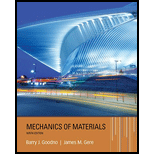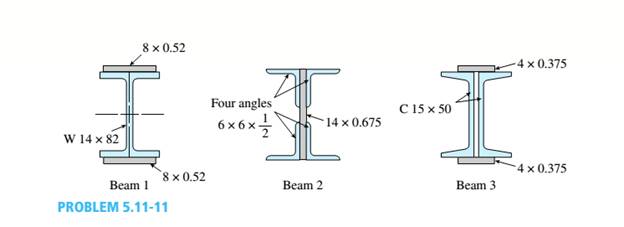
The three beams shown have approximately the same cross-sectional area. Beam 1 is a W 14 X 82 with flange plates; beam 2 consists of a web plate with four angles; and beam 3 is constructed of 2 C shapes with flange plates.
- Which design has the largest moment capacity?
- Which has the largest shear capacity?
- Which is the most economical in bending?
- Which is the most economical in shear?
Assume allowable stress values are: = 18 ksi and ra=11 ksi. The most economical beam is that having the largest capacity-to-weight ratio. Neglect fabrication costs in answering parts (c) and (d) above. Note: Obtain the dimensions and properties of all rolled shapes from tables in Appendix F.

The beam of the largest momentum capacity.
Answer to Problem 5.11.11P
The beam of the largest momentum capacity is beam-1.
Explanation of Solution
Given information:
The allowable normal stress is
Write the expression for the total moment of inertia of the beam-1.
Here, the total moment of inertia of the beam-1.is
Write the expression for the total height of the beam-1.
Here, the total height of the beam-1 is
Write the expression for the total area of the beam-1.
Here, the total area of the beam-1.is
Write the expression for the section of the modulus of the beam-1.
Here, the section of the modulus of the beam-1
Write the expression for the total moment of inertia of the beam-2.
Here, the total moment of inertia of the beam-2 is
Write the expression for the total area of the beam-2.
Here, the total area of the beam-2 is
Write the expression for the section of the modulus of the beam-2.
Here, the section of the modulus of the beam-2 is
Write the expression for the total height of beam-3.
Here, the total height of beam-3 is
Write the expression for the total moment of inertia of the beam-3.
Here, the total moment of inertia of the beam-2 is
Write the expression for the total area of the beam-3.
Here, the total area of the beam-3 is
Write the expression for the section of the modulus of the beam-3.
Here, the section of the modulus of the beam-3
Calculation:
Refer Table-F-1(a) “Properties of wide flange section” to obtain
Substitute
Substitute
Substitute
Substitute
Refer Table-F-4(a) “Properties of wide equal legs L-shape channel”
Substitute
Substitute
Substitute
Refer Table-F-3(a) “Properties of C-shape channel” for
Substitute
Substitute
Substitute
Substitute
Since stress due to moment is inversely proportional to section modulus, therefore the beam which has the highest section modulus will have the highest capacity.
The value of the section modulus of the beam-1 is highest i.e.,
Conclusion:
The beam of the largest momentum capacity. is beam-1.
Want to see more full solutions like this?
Chapter 5 Solutions
Mechanics of Materials (MindTap Course List)
- (Read image)arrow_forward(Read Image)arrow_forwardM16x2 grade 8.8 bolts No. 25 C1- Q.2. The figure is a cross section of a grade 25 cast-iron pressure vessel. A total of N, M16x2.0 grade 8.8 bolts are to be used to resist a separating force of 160 kN. (a) Determine ks, km, and C. (b) Find the number of bolts required for a load factor of 2 where the bolts may be reused when the joint 19 mm is taken apart. (c) with the number of bolts obtained in (b), determine the realized load factor for overload, the yielding factor of safety, and the separation factor of safety. 19 mmarrow_forward
- Problem4. The thin uniform disk of mass m = 1-kg and radius R = 0.1m spins about the bent shaft OG with the angular speed w2 = 20 rad/s. At the same time, the shaft rotates about the z-axis with the angular speed 001 = 10 rad/s. The angle between the bent portion of the shaft and the z-axis is ẞ = 35°. The mass of the shaft is negligible compared to the mass of the disk. a. Find the angular momentum of the disk with respect to point G, based on the axis orientation as shown. Include an MVD in your solution. b. Find the angular momentum of the disk with respect to point O, based on the axis orientation as shown. (Note: O is NOT the center of fixed-point rotation.) c. Find the kinetic energy of the assembly. z R R 002 2R x Answer: H = -0.046ĵ-0.040 kg-m²/sec Ho=-0.146-0.015 kg-m²/sec T 0.518 N-m =arrow_forwardProblem 3. The assembly shown consists of a solid sphere of mass m and the uniform slender rod of the same mass, both of which are welded to the shaft. The assembly is rotating with angular velocity w at a particular moment. Find the angular momentum with respect to point O, in terms of the axes shown. Answer: Ñ。 = ½mc²wcosßsinßĵ + (}{mr²w + 2mb²w + ½ mc²wcos²ß) k 3 m r b 2 C لا marrow_forwardOnly question 2arrow_forward
- Only question 1arrow_forwardOnly question 3arrow_forwardI have Euler parameters that describe the orientation of N relative to Q, e = -0.7071*n3, e4 = 0.7071. I have Euler parameters that describe the orientation of U relative to N, e = -1/sqrt(3)*n1, e4 = sqrt(2/3). After using euler parameter rule of successive rotations, I get euler parameters that describe the orientation of U relative to Q, e = -0.4082*n1 - 0.4082*n2 - 0.5774*n3. I need euler parameters that describe the orientation of U relative to Q in vector basis of q instead of n. How do I get that?arrow_forward
- Describe at least 4 processes in engineering where control charts are (or should be) appliedarrow_forwardDescribe at least two (2) processes where control charts are (or should be) applied.arrow_forwardProblem 3: A cube-shaped spacecraft is in a circular Earth orbit. Let N (n,) be inertial and the spacecraft is denoted S (ŝ₁). The spacecraft is described such that ¯½º = J ŝ₁ŝ₁ + J ŝ₂§₂ + J §¸Ŝ3 Location of the spacecraft in the orbit is determined by the orbit-fixed unit vectors ê, that are oriented by the angle (Qt), where is a constant angular rate. 52 €3 3> 2t 55 Λ Из At the instant when Qt = 90°, the spacecraft S is oriented relative to the orbit such that 8₁ = 0° Space-three 1-2-3 angles 0₂ = 60° and ES = $₂ rad/s 0₁ = 135° (a) At this instant, determine the direction cosine matrix that describes the orientation of the spacecraft with respect to the inertial frame N.arrow_forward
 Mechanics of Materials (MindTap Course List)Mechanical EngineeringISBN:9781337093347Author:Barry J. Goodno, James M. GerePublisher:Cengage Learning
Mechanics of Materials (MindTap Course List)Mechanical EngineeringISBN:9781337093347Author:Barry J. Goodno, James M. GerePublisher:Cengage Learning
